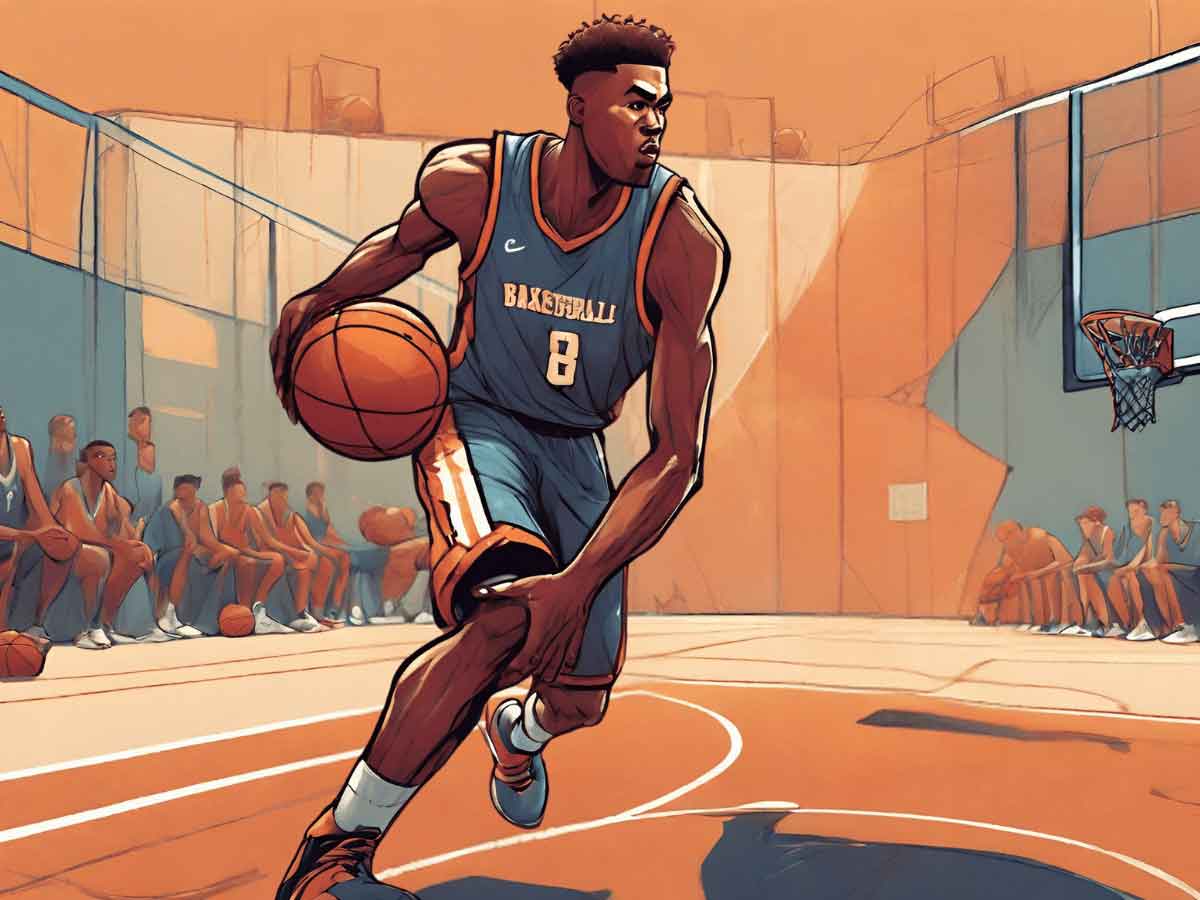A double dribble in basketball is almost always a controversial call (or no call) by the referees. The violation can get a bit tricky, and sometimes even the referees miss it. So, what is a double dribble exactly? Imagine a player dribbles, then holds it briefly, only to start dribbling again. Or picture someone trying to dribble with both hands at the same time. Both are big no-nos in basketball.
Key Takeaways:
- Double dribble is a violation that happens when a player voluntarily stops dribbling and starts again, or dribbles using both hands.
- Get called for a double dribble, and the other team gets the ball.
- Double dribble is not the same as traveling, which is when a player moves too much without dribbling.
But why should you care about double dribbling? It’s not just about following the rules to avoid penalties. We’re going to look into what makes a double dribble, why sometimes it’s missed by the refs, what happens when it’s called, and how you, as a player, can steer clear of it.
What is a Double Dribble?
A double dribble is when a player violates the dribbling rules in one of two ways:
- Dribbling, Stopping, and Dribbling Again:
- A Player dribbles the ball.
- Then, they decide to stop and hold the ball with one or both hands.
- Suddenly, the player starts dribbling again after having stopped. That’s a no-go!
- Two-Handed Dribbling:
- A player uses both hands at the same time to dribble the ball, instead of using just one.
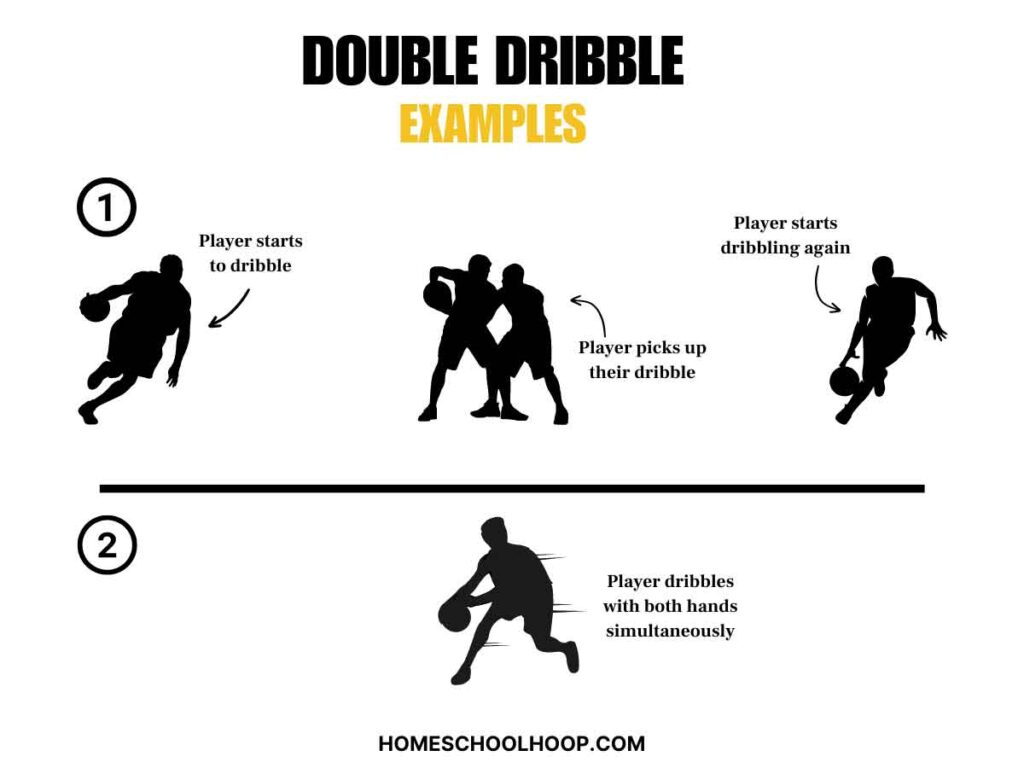
Back in the early 1900s, dribbling was defined as the “continuous passage of the ball.” This evolution meant you had to keep your dribble going and made double dribbling officially illegal. The rule was meant to keep things fair. Without it, players could stop and start dribbling again or use both hands, giving them an unfair advantage over their defenders.
How the Rules by League Vary
Not all basketball leagues and organizations play by the same rulebook, but when it comes to double dribbling, they’re pretty much on the same page. Here’s how it breaks down:
NBA and WNBA:
- Both the NBA and WNBA have specific rules around double dribbling in their official rulebooks.
- According to NBA Rule No. 10 Section II, “A player may not dribble a second time after he has voluntarily ended his double dribble.”
- Get caught? The other team gets the ball on the sideline near where the violation occurs, but no closer to the baseline than the foul line extended.
NCAA Men’s and Women’s Basketball:
- In college ball, the same no-double-dribble rule applies.
- Like in the NBA/WNBA, a double dribble violation means the ball goes to the opposing team. They get it out-of-bounds near where the violation took place (there’s no foul line limitation like in the professional leagues).
FIBA:
- International games follow the same double-double principles as those in the NBA/WNBA.
- Rule 24.2 in the FIBA Rulebook reads, “A player shall now dribble for a second time after his/her first dribble has ended unless between the 2 dribbles he/she lost control of a live ball on the court because of: A shot for a goal, A touch of the ball by an opponent, A pass or fumble that has touched or been touched by another player.”
- If the violation is called, the other team gets the ball on the sideline, near where the violation happened.
Exceptions to the Rule
Believe it or not, there are a few times when you can pick up that dribble and go at it again without the refs blowing their whistles:
Going for a Shot
If a player picks up their dribble to shoot a field goal attempt and get their rebound, they can dribble a second time even if nobody else has touched it first.
Ball Gets Knocked Loose
If a player picks up their dribble and the defender taps it out of their hands, it’s fair game for the offensive player to retrieve it and start dribbling again.
A Pass That is Touched
A player who picks up their dribble and passes the ball can retrieve it and start dribbling again, as long as it’s first touched by another player.
Differences Between Double Dribble and Other Dribbling Violations
The double dribble is one type of dribbling violation in basketball, just like travel and carry are. Here’s how it is different from these other mistakes.
Double Dribble vs. Travel
A double dribble occurs when a player stops dribbling, holds the ball, and starts dribbling again. Or, they dribble with both hands. It focuses on the act of dribbling incorrectly.
Traveling in basketball, on the other hand, happens when a player moves their feet in excess without dribbling the ball. It’s more about moving without maintaining a dribble.
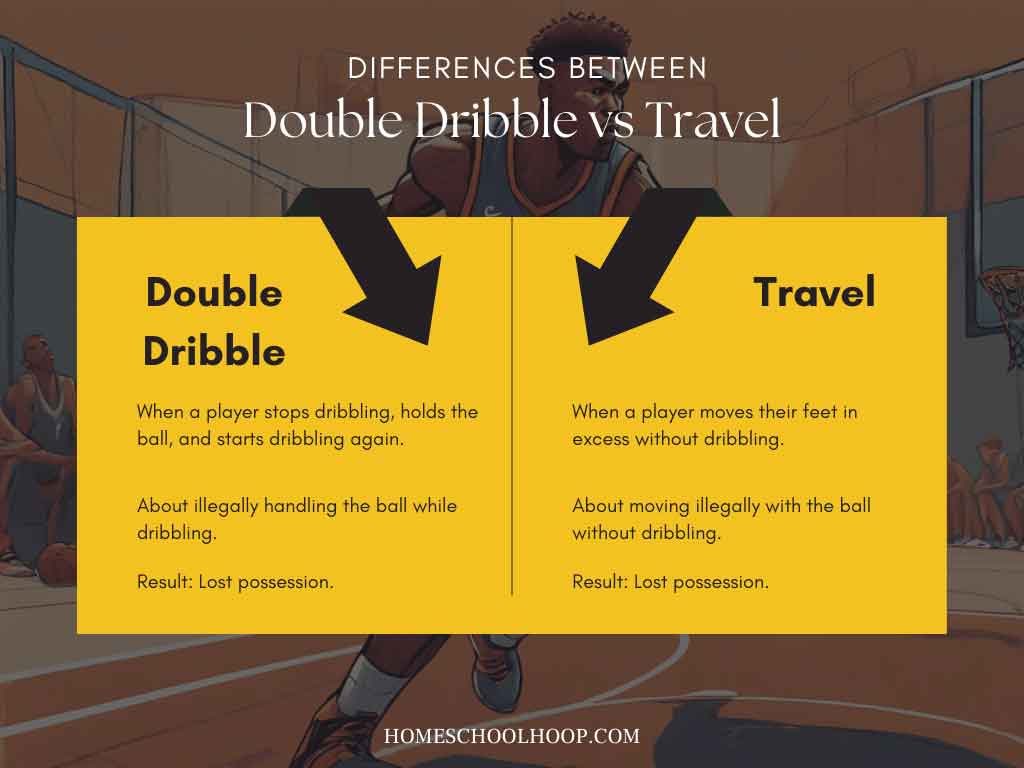
Double Dribble vs. Carry
As explained, the double dribble is about restarting your dribble after a pause of using both hands.
A carry in basketball is when a player turns their hand under the ball and carries it from one point to another while dribbling. It’s related to the ball resting in the dribbler’s hand too long.
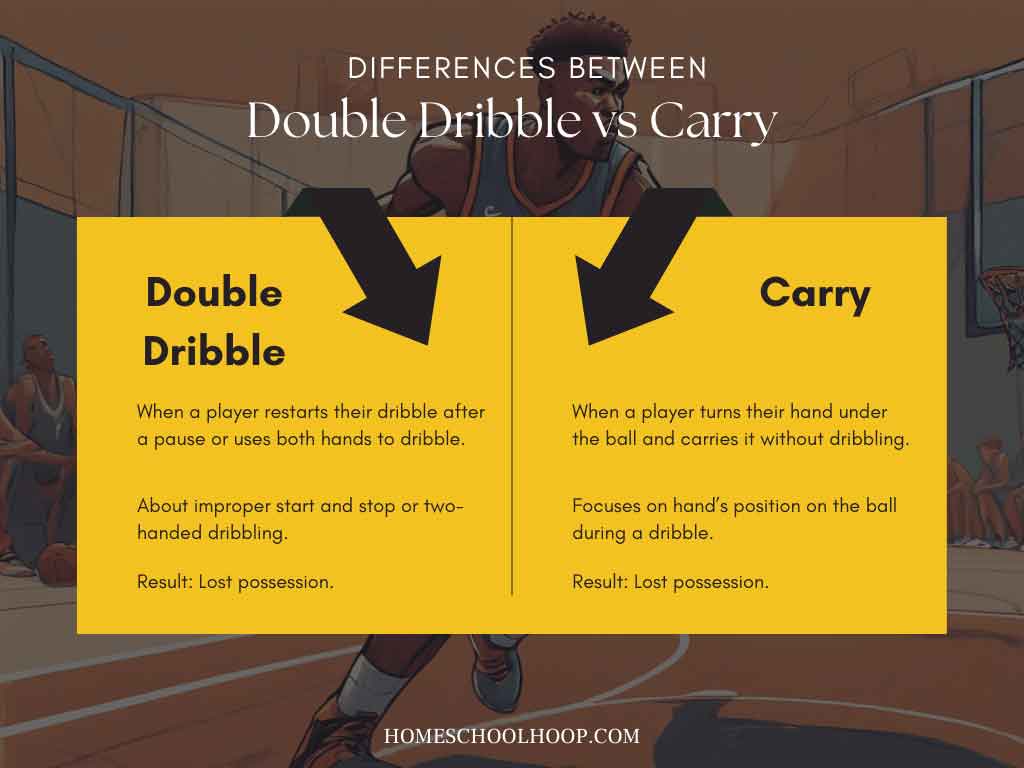
The Impact of Double Dribble in Games
When a player gets called for a double dribble, sometimes it’s just a simple mistake; in others, it’s a game changer.
This violation doesn’t just pause the action; it can actually swing the game’s momentum, affecting which team has more chances to score. That’s why it’s taken seriously by both offenses and defenses.
What is the Penalty for a Double Dribble?
Okay, so a player messes up and double dribbles. What’s next? Here’s what you need to know:
- Whistle Blow: Play stops straight then and there with the sound of a referee’s whistle.
- Change of hands: The other team is awarded the ball. Yes, it’s a turnover in basketball.
- A new opportunity: The opposing team now on offense gets to throw the ball in from the sideline, setting them up for an additional chance to score.
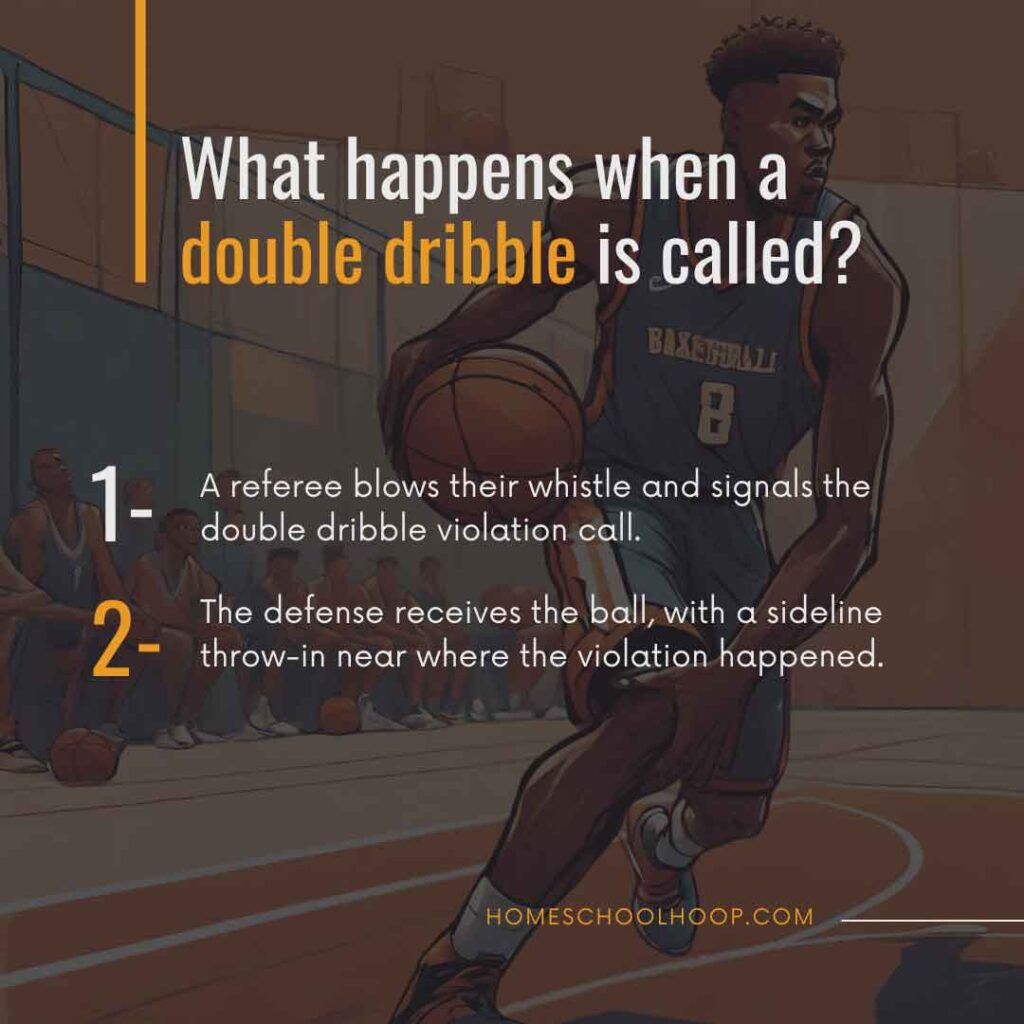
This is why dribbling skills are a big deal in basketball, and why coaches are always talking about keeping control of the ball.
How Double Dribble Impacts Strategy
Double dribble might not be the first thing on everyone’s mind during a game, but it definitely shapes how teams play, from offense to defense. Here’s how:
On Offense:
- Ball Control: Players work hard at developing their ball-handling skills so they’re able to successfully navigate pressure without getting into a position where they’re forced to pick up their dribble.
- Smart Moves: It encourages players to read the defense and make decisive moves so they can avoid getting cornered. For example, a quality guard will foresee an oncoming trap and either dribble away or get rid of the ball so they don’t accidentally double dribble.
On Defense:
- Turning Up the Ball Pressure: Good defensive players and teams will pressure dribblers, particularly those who struggle to handle the ball, with the hope they’ll force a mistake like a double dribble.
- Cutting Off Options: The defense can also encourage opponents to double dribble by denying passes. If a player has to pick up their dribble and doesn’t have an outlet, they may be forced to double dribble or throw it away.
Notable Double Dribble Moments
Sometimes, the difference between winning and losing hinges on the rules. Double dribble violations, whether called or missed, can change the game. Let’s explore two times this rule made headlines and left fans talking after the final buzzer.
Pascal Siakam’s Costly Mistake
In a nail-biting regular season game in 2021 between the Toronto Raptors and the New York Knicks, Pascal Siakam committed a double dribble with only 9 seconds left on the clock, and the Raptors trailing by 2 points.
- The Consequence: That slip-up forced the Raptors into a tough spot. They had to commit an intentional foul to try to keep the game alive by extending its duration. But no luck – they still lost the game 102-96.
- Why It Matters: Siakam’s mistake shows how crucial it is to maintain composure, especially in the game’s critical moments.
Missed Call in the Eastern Conference Finals
With 3 seconds left in Game 6 of the 2023 NBA Eastern Conference Finals between the Miami Heat and the Boston Celtics, the referees missed a double dribble violation by Jimmy Butler of the Miami Heat.
- What Happened: Instead of calling the double dribble, the referees ruled Butler was fouled while attempting a three-point shot and awarded him three free throws.
- The Outcome: Despite this controversial no-call, the Boston Celtics managed to hold on and win the game by a single point.
Avoiding Double Dribble – Tips for Players
You don’t want to be that player who accidentally hands the ball over to the other team. Double dribbling gives away the ball and shifts the game’s momentum to the other team. Here are some straightforward ways to reduce your risk of turning the ball over with a dribbling mishap.
Know the Rulebook
First things first: know the definition of a double dribble. Make sure you fully understand what it means. Remember, it’s a no-no to pick up your dribble and then start dribbling again, or to use both hands to dribble the ball. Knowing the rules is your first defense against making this common mistake.
Dribble Drill Time
Your dribbling abilities come from practice, practice, and more practice. When you feel more confident and comfortable, you’ll stay composed and avoid double-dribble violations. Here are some drills and exercises that can help:
- One-Handed Dribble:
- Focus on controlling the ball with one hand at a time.
- Practice zig-zagging around cones or markers to improve agility and control.
- Change of Pace Dribble:
- Work on changing your dribbling speed suddenly.
- This helps in real-game situations where you need to get away from defenders.
- Tight Spaces Dribbling:
- Set up an obstacle course with cones or chairs.
- Dribble through the path without losing control of the ball, focusing on keeping your dribble low and controlled.
Strengthen Your Non-Dominant Hand
A common cause of double dribbling is a lack of confidence in using your non-dominant hand. Time to bring it up to speed.
- Practice dribbling with your non-dominant hand for a portion of every training session.
- By strengthening your weaker hand, you’ll be more comfortable using it in games.
Simulate Game Scenarios
Practicing dribbling through drills is one thing, but simulating game scenarios can prepare you for the pressure of an actual game.
- Organize a basketball scrimmage or drills that feel like the real deal.
- Focus on maintaining control of the ball, especially when making quick decisions when the heat is on.
Stay Aware and Focused
Lastly, always know where the defenders are and anticipate what your next move will be. Keeping your focus can help you avoid situations where you might lose control and accidentally double dribble.
- Practice keeping your head up while dribbling to improve your court vision.
- Sharpen those decision-making skills to better anticipate defenders’ actions and avoid panicking with the ball.
The Role of Officials in Identifying Double Dribble
Referees play a crucial role in ensuring every game runs smoothly and fairly. It’s a hard job and they have a lot of responsibility. But, ask any basketball fan, and they’ll tell you–referees miss calls sometimes.
The double dribble, whether a referee calls it or misses it, is one that often invites criticism. Even with their expertise and sharp eyes, referees sometimes miss them. Here’s why that can happen:
- It’s a fast-paced game: You’ve got players and a ball constantly moving. This speed can make it tough to catch every violation and foul.
- Obstructed view: Refs can’t be everywhere at once, and sometimes other players block their view of a double dribble.
- Focus on multiple violations: Officials are watching for all sorts of infractions, not just double dribbles. Balancing this attention can sometimes lead to incorrect or missed calls.
- Human error: Referees are human, so they will make mistakes. They might misinterpret a move or miss seeing a violation in the heat of a moment.
FAQs
What is the difference between double dribble and traveling?
Double dribble occurs when a player stops dribbling, then starts again, or uses both hands to dribble. Traveling happens when a player takes too many steps without dribbling. Essentially, double dribble is about incorrect dribbling, while traveling is about moving illegally without dribbling.
Is it a double dribble if you drop the ball?
No, if the ball just slips out of your hands, you’re totally fine to pick it up and keep going. The trouble only starts if you’re dribbling, take a break to hold the ball, and then decide to dribble again. That’s when it becomes a double dribble.
What counts as a double dribble?
A double dribble counts when:
- You dribble, decide to stop and hold onto it, then start dribbling again.
- You use both hands simultaneously to dribble the ball.
Why is dribbling with two hands illegal?
Dribbling with two hands is illegal because it gives the offensive player too much control over the ball, making it harder for defenders to challenge.
LET US KNOW
Today, you learned about the double dribble in basketball.
So we want to know: What do you think about how double dribble violations are called in professional games? Do you think referees should be stricter or more lenient with these calls?
Let us know your thoughts and why you feel that way in the comments.

